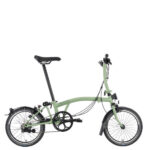Upgrading bike tires often promises enhanced performance, but sometimes, the reality on the road can be surprising. Like many e-bike enthusiasts, I recently switched to Schwalbe Marathon Plus tires, influenced by their stock inclusion on Juiced’s new CCX models, assuming they represented a step up from my previous Kenda Bike Tires. However, my experience revealed a significant difference, particularly in braking performance, and not in a positive way.
Right from the first ride, the braking capability of the Schwalbe tires felt noticeably diminished compared to what I was accustomed to with my Kenda tires. This was especially pronounced in wet conditions. Applying the rear brake in the rain led to an unnerving, extended slide, feeling as though the tire would never regain traction. Similarly, even a moderate squeeze on the front brake risked locking the wheel, a precarious situation for any cyclist. Even on dry pavement, the overall braking performance was undeniably inferior to my previous experience with Kenda tires.
It’s important to note that these observations are based on my daily commute, on familiar routes and conditions. I have extensive experience riding my bike with Kenda tires, making it clear that this isn’t a matter of placebo or adjusting to a new bike feel. To give Schwalbe a fair chance, I rode on them for three weeks, thinking there might be a break-in period, similar to new motorcycle tires which can initially be slippery. However, the braking performance consistently remained below the standard set by my previous Kenda tires.
Curious about this discrepancy, I decided to directly compare the Schwalbe tires to my old Kenda tires, which I thankfully hadn’t discarded yet. The visual inspection revealed a fundamental difference in tire structure. The Schwalbe tires exhibited a more oval profile, while the Kenda tires presented a flatter shape. While my used Kenda tires were somewhat “squared off” from daily use, the original design clearly indicated a flatter profile compared to the inherently more rounded Schwalbe. Additionally, the Kenda tires appeared slightly wider, despite both being labeled as 700c-45c.
Alt text: Side-by-side comparison of Kenda bike tire and Schwalbe tire profiles, highlighting the flatter shape of the Kenda tire.
This difference in shape naturally translates to a different contact patch with the road surface. While Schwalbe is undoubtedly a reputable brand known for build quality – the Marathon Plus felt heavier and more robust than the Kenda – the trade-off in tire shape seems to impact braking. It’s plausible that the more rounded profile of the Schwalbe, while potentially reducing rolling resistance, also diminishes the contact area crucial for effective braking.
Could it be that the lower rolling resistance of the Schwalbe Marathon Plus comes at the cost of braking performance? This experience has left me wondering if other Juiced bike owners, who have also transitioned from Kenda to Schwalbe tires, have noticed a similar change in braking feel. Sharing experiences could shed light on whether this is a common observation or specific to my setup.
Alt text: Close-up view of a Schwalbe bike tire, emphasizing its oval-shaped profile and tire tread pattern.
In conclusion, while Schwalbe Marathon Plus tires are often considered a premium upgrade, my personal experience indicates a noticeable decrease in braking performance compared to Kenda bike tires, especially in wet conditions. The difference in tire shape and resulting contact patch may be a contributing factor. It would be valuable to hear from other riders who have made a similar switch to understand if this is a widespread experience when moving from Kenda to Schwalbe tires on electric bikes.

